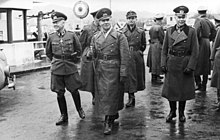Hans von Obstfelder

Hans von Obstfelder (born September 6, 1886 in Steinbach-Hallenberg , † December 20, 1976 in Emstal near Kassel ) was a German infantry general during the Second World War .
career
In 1906, Obstfelder joined the 2nd Thuringian Infantry Regiment No. 32 of the Prussian Army as an ensign . At the beginning of the First World War he was a first lieutenant and served on the Western Front . At the end of the war he was a captain and was accepted into the Reichswehr . After his promotion to major on February 1, 1926 and to lieutenant colonel in 1930, Obstfelder was promoted to colonel in 1933 . After a few transfers he became major general and was entrusted with the leadership of the 3rd Infantry Division . On February 1, 1938 he became lieutenant general . During the invasion of Poland , he led the 28th Infantry Division . In the French campaign on June 1, 1940 promoted to general of the infantry, he commanded the XXIX with success . Army corps ; The corps was then transferred to Slovakia and placed under Panzer Group 1 .
In the Russian campaign he was awarded the Knight's Cross of the Iron Cross on July 27, 1941 . After the advance into the Caucasus , retreat fights on the Mius followed in the summer of 1943 . With heavy losses, the corps was able to hold up the Red Army , for which von Obstfelder was awarded the Oak Leaves for the Knight's Cross of the Iron Cross on June 7, 1943. The Germans were also able to stop the Donets-Mius offensive (July 17 and August 2, 1943). The Donets Basin operation (August 16 and September 22, 1943) was very costly for both sides.
In August 1944, parts of his corps in France were destroyed in the Falaise pocket. For heavy defensive battles, on November 5, 1944, Obstfelder received the swords for the Knight's Cross of the Iron Cross.
On March 25, 1945, Obstfelder succeeded General Hans-Gustav Felber as Commander-in-Chief of the 7th Army . Two days earlier, US troops under General Patton had successfully crossed the Rhine at Nierstein in Felber's command area . By the end of April, the troops under Obstfelder's command withdrew to the Ore Mountains and the Bohemian Forest . On April 22nd, Obstfelder had the commander of his rear army area, Major General Reinhold Gothsche , and another officer shot because they had expressed doubts about the final victory.
After the surrender, on May 8, 1945, most of his army was taken prisoner by the Americans . In the period that followed, until his release in August 1947, he served as a liaison officer to the 12th US Army Group .
Until his death he lived withdrawn in Wiesbaden and later in a senior citizens' residence in Kassel-Wilhelmshöhe . He died on December 20, 1976.
Awards
- Iron Cross (1914) 2nd and 1st class
- Hanseatic Cross Hamburg
- Knight's Cross II. Class of the House Order of the White Falcon with Swords
- Knight's Cross 1st Class of the Saxon-Ernestine House Order with swords
- Wehrmacht service award IV. To I. class
- Clasp for the Iron Cross, 2nd and 1st class
-
Knight's Cross of the Iron Cross with oak leaves and swords
- Knight's Cross on July 27, 1941
- Oak leaves on June 7, 1943 (251st award)
- Swords on November 5, 1944 (110th award)
- German cross in gold on April 21, 1943
Individual evidence
- ↑ Death register of the registry office Emstal No. 101/1976.
- ↑ a b c d Ranking list of the German Reichsheeres , Mittler & Sohn Verlag, Berlin, p. 119.
- ↑ a b Veit Scherzer : Knight's Cross bearer 1939–1945. The holders of the Iron Cross of the Army, Air Force, Navy, Waffen-SS, Volkssturm and armed forces allied with Germany according to the documents of the Federal Archives. 2nd Edition. Scherzers Militaer-Verlag, Ranis / Jena 2007, ISBN 978-3-938845-17-2 , p. 575.
| personal data | |
|---|---|
| SURNAME | Obstfelder, Hans von |
| BRIEF DESCRIPTION | German infantry general in World War II |
| DATE OF BIRTH | September 6, 1886 |
| PLACE OF BIRTH | Steinbach-Hallenberg |
| DATE OF DEATH | 20th December 1976 |
| Place of death | Emstal near Kassel |